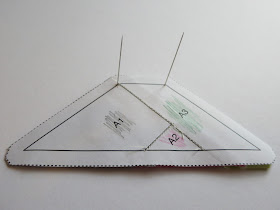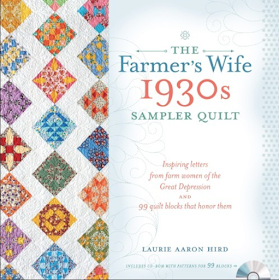Hello Farmer's Wifers, it's Posy time. I liked making Posy. My last Farmer's Wife block tutorial was for block 87 Prudence, who is still no friend of mine. Like Prudence, Posy involves y-seams but they are much gentler. Posy is definitely a much happier block to sew.
My tutorial is for foundation paper-piecing (FPP) Posy. I created a FPP tutorial for block 1 Addie, and have decided to create nearly-a-full FPP tutorial for Posy too (there aren't as many step-by-step pics for Posy as there were for Addie, so please click through to Addie if you need more detailed info).
And if FPP + y-seams aren't your happy home, Angie has created an alternate block this week - I've included the link right at the bottom of this post :-)
Let's go.
Preparing to FPP
1. The first step is to print off your templates, being sure to have your printer set to 100% (or 'no scale'). Check the one-inch line with a quilting ruler.
2. Decide on your fabrics and colour in or label your block diagram and the corresponding template pieces, so you can keep track of which fabric to sew onto which template piece once they're all cut up and don't make a lot of sense - I forgot to take a block diagram + fabric choice pic of Posy, so see below for a pic of Prudence (so nice of past-Prudence to step up and show a bit of kindness).
3. Use paper scissors to cut out all your template sections, just roughly around the outside, there's no need to cut directly on the dotted outside edge (note that the solid line is the line on which you will sew, and the dotted line is the outside edge, with the seam allowance in between).
Time to join fabric to paper
4. Work through all your template sections, and glue the first fabric piece onto the first template piece. I use a swish of Sewline glue pen to glue the wrong side of the fabric to the unprinted side of the paper template. To be sure you are gluing the fabric in the correct place, hold your paper template up to the light (a window or a light box if you have one) and position the first fabric piece over the first template piece, being sure to leave a 1/4" seam allowance around all edges of the template piece.
5. Work through all your template sections again, carefully pinning your second fabric piece in place. Place your second fabric RST (right sides together) with your first piece, with at least a 1/4" seam allowance extending into the template's second piece. Pin in place along the sew-line between the first and second template pieces, then flip your second fabric piece over to check that it covers the whole area plus seam allowance.
6. Take all your template sections to your sewing machine. Set the stitch length to 18-20 stitches per inch for your machine - on my Bernina, it's 1.5. I sew all my FPP blocks with the Bernina 1/4" number 37 foot - you need an open-toe foot of some kind, so you can easily see where you are headed.
7. Sew directly on the printed sew line. Be sure to backstitch at the start and end of your sew line. For sew lines that start/finish within the block, be sure to start/stop directly on the sew line. For sew lines that start/stop on an external edge of the block, it's fine to sew into the seam allowance (doing this just makes removing your papers later a little more fiddly, but it makes your block a little more secure).

Trimming + ironing
8. Once you have sewed the second piece to the first piece on all your template sections, take the sections to your cutting mat and lay them fabric-side down, being sure that your fabric pieces are still RST, and haven't flipped over - you don't want to trim off the piece you have just sewed. Fold template piece 2 down onto template piece 1, along the line you just sewed. Line the 1/4" line of your ruler directly along the fold line, and trim your seam allowance to 1/4". Do this for all your section pieces, and then take them to the ironing board.
Note that for the trimming step of all FPP patterns, you will always fold down the bigger template number onto the smaller template number, to trim the seam allowance - so be sure to always follow the numbered piecing order.
9. Flip over and press your second piece down flat - be sure to press down rather than swoosh the iron all about, so your fabric pieces don't shift.
10. Repeat steps 1-9 until all your template sections are finished.
11. Once all your sections are finished, press them flat with the iron, then trim around the external edges, directly on the external section lines - refer to the pic below under step 12.
Joining sections together
12. Now to join the sections together. To be sure your template sections meet up correctly, place pins through external sew line meeting-points - refer to the pics below as an example (joining section A to section J).


13. I then pop a Wonder clip or two between my pins, so that the section pieces can't move. Remove the pins + clips as you join each section together, sewing from paper-edge to paper-edge along the sew line.
As with all FPP patterns, follow the piecing order given in the book.
Just note - when joining the little triangles J-Q, be sure that all the letters read the right way up, then flip the little triangle over to join to the bigger piece (e.g. K to B in the pic below - see how all the letters + numbers are running in the same direction).

Add extra pins along the sew line as needed, to help the sections meet accurately - see pic below, where I have added pins either side of A2, as well as on the outer corners.

14. After you join each section to the next, iron the seams open - you can remove the paper within the seam allowance at this point.


Joining corner sections to the middle sections R + S
15. Once you have finished sewing each template section, lay out your block next to your machine, with the paper-side facing upwards and the fabric facing downwards. Check again that all the little triangles have the printed writing running up the correct way

16. It's y-seam time. Start on the paper-edge and sew along the long edge towards the smaller line (refer to the pic below, sewing S to AJ). When you get to the y-intersection, exactly where the pin is:
- lower your needle
- lift your presser foot
- pivot the block
- lower your presser foot
- continue sewing along the smaller line to the paper-edge.
It totally works fine, I swear! - just go slow and steady.

Joining the top + bottom sections to I
17. Take care when joining the top and bottom sections to I, as the fabric on the outer tips will want to shift - I used my Sewline glue pen to swish glue on the outer tips of I1 and I3, to ensure the fabric did not lift away from the paper as I sewed.
18. I'm not the world's best y-seam sew-er, so to make life easy, I started right in the middle of I2 and sewed out towards the end of I1, then followed the same steps within step 16 above to sew to the outer edge. I then repeated it all again to sew from the middle of I2 (overlapping my stitches a little) to sew to the outer edge of I3.
19. Press your seams open - and you are done! - hopefully all your seams will have matched up happily.
You have finished Posy! - block 84 is done.
Remember that all the Farmer's Wife info is on Angie's blog - which is home base for the sew along. The book you will need is The Farmer's Wife 1930s Sampler Quilt: Inspiring Letters from Farm Women of the Great Depression and 99 quilt blocks that honour them by Laurie Aaron Hird for Fons & Porter/F+W; RRP $28.99 (though it's currently on sale!) - click here to purchase.
Did you see that Angie sewed an alternate to Posy this week? - block 84a Ruth - using Marti Michell templates (to avoid sewing a FPP y-seam block) - so if you'd prefer to sew Ruth instead of Posy, please click on through. Angie's post includes the links to Marti's chart + template info.
Angie's post also includes all the upcoming blog links for the remaining blocks - we'll be starting back again in the new year.
I hope you all have a very Merry Christmas, and a happy + relaxing holiday time with your family + friends. All the best for a very peaceful, healthy + content 2017. Thanks for stopping by xoxo cat
































